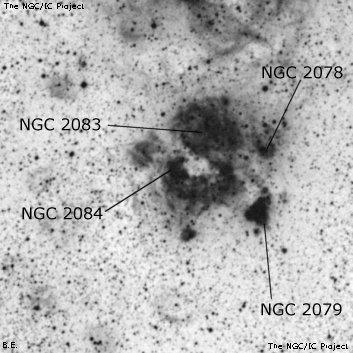NGC/IC Project Restoration Effort
(This is a very very beta version)
NGC2084


Basic Information
Location and Magnitude
Right Ascension: 5:40:7.1
Declination: -69:45:34
Constellation: DOR
Visual Magnitude:
Historic Information
Discoverer: Dunlop
Year of discovery: 1826
Discovery aperture: 9.0
Observational
Summary description: neb, sf of gr of 7
Sub-type: EN
Corwin's Notes
=====
NGC 2084. See NGC 2077. Three of the nebulae that JH shows in his figure
that he did not include in CGH (and thus not in GC, or Dreyer later, in NGC)
are near this star-forming region. I've given positions for them from the
DSS1R image.
Steve's Notes
=====
NGC 2084
24" (4/10/08 - Magellan Observatory, Australia): I returned to this detailed nebula the following night to make a complete observation at 200x using a UHC filter. NGC 2084 forms the SE region of the complex and it's composed of several nearby components. At the NE end of this extended region is a moderately bright, round knot, ~45" diameter (N159G). Without a filter a star is involved with N159G (sketched by John Herschel but not catalogued). A second, brighter embedded "glow" is close WSW on a direct line with NGC 2079. This knot corresponds with John Herschel's position for NGC 2084 and is catalogued by Henize as N159C-east. It appeared very bright, fairly large, elongated, ~1.2'x1.0'. Removing the filter a couple of stars are involved (with one brighter star). Finally, N159C-west (also sketched by Herschel) lies 1.5' W of NGC 2084 = N159C-east in the center of the entire complex and is connected to NGC 2084 by a faint bridge of nebulosity. N159C-west (also sketched by John Herschel but not catalogued) appeared fairly bright, moderately large, round, 45" diameter.
24" (4/9/08 - Magellan Observatory, Australia): this is the SE component of a fascinating 4' HII complex filled with up to 8 distinguishable knots (4 have NGC numbers) with several of the brighter knots forming an "S" shape (this knot is at SE end of the "S"). At 200x and UHC filter it appeared very bright, round, fairly large glow, 1' diameter and encased within fainter nebulous haze that extends to the west. NGC 2083 lies 1.5' NNW within the background glow that envelopes the entire complex.



